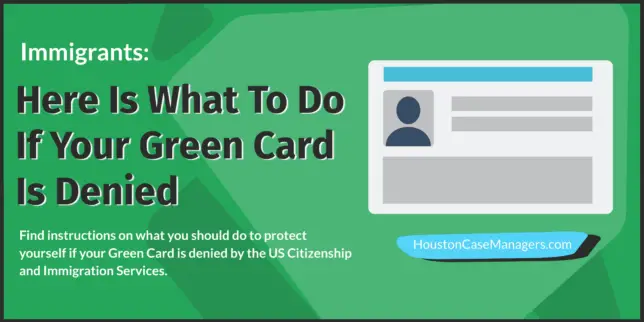Immigrants: What To Do If Your Green Card Is Denied
U.S. law provides certain rights and protections to immigrants in their quest to remain in the country permanently. While this article cannot replace the advice of an immigration appeals lawyer, it will provide you with information you can use if the U.S. Citizenship and Immigration Services (USCIS) denies your application
First You Must Act Quickly If Your Green Card Is Denied
After a denial of residency or a removal proceeding, the EOCIR and USCIS courts only accept appeals within 30 days of their final decision. When residency status is revoked, the USCIS only allows 14 days to file an appeal. Whichever class of decision you need to appeal, it is vitally important that you act quickly in choosing the right immigration lawyer.
What To Do If Your Initial Petition Is Denied
If USCIS denies your initial petition, your attorney will probably advise you to just start over and file a new petition. While there is an appeal process, it is not often used.
What To Do If Your Green Card Is Denied
If your Green Card is denied you will need to:
- Appeal the decision
- File a motion for reconsideration of your petition
- File a motion to reopen your case
Here are more details on these steps…
Appeal The Decision
If you want to adjust your status in the U.S. and you apply for a green card but are denied, you will receive a USCIS notice of the denial and whether and how you can appeal that decision. For most, no appeal is available. But if you can appeal, you appeal to the USCIS Administrative Appeals Office (the AAO). Pay close attention to the filing deadline and of course, there will be a filing fee.
File a Motion for Reconsideration of Your Petition
If an appeal is not available to you, your attorney can file a motion for reconsideration. You are asking the USCIS to change its mind regarding your petition, and you have to provide reasons why the decision was wrong.
File a Motion for Reopening Your Case
If your situation has changed since you filed your petition, or new facts have come to light since the decision was made, you can file a motion to reopen your case and have the USCIS make a new decision based on current information.
What To Do If Removal Proceedings Are Scheduled
You will need to apply for Legal Asylum in the U.S.
Who Is Eligible For Legal Asylum
If you cannot return home because you have been persecuted or there is a reasonable possibility of persecution in your home country, by the government or a group the government can not or will not control, because of your political opinions, religion, race, or membership in a social group, you may be eligible for asylum. Persecution usually takes the form of violence or imprisonment or fear of the same.
Applying For Asylum Prior To Removal Proceedings
You can apply for legal asylum with the U.S. Citizenship and Immigration Services (USCIS) as long as you are not currently in immigration court removal proceedings. You need to file your application with the Asylum Office within one (1) year of entering the U.S. Even if you have been in the country for more than a year, there are circumstances under which you can still apply –talk with your attorney.
The Asylum Office will interview you and issue a decision within two months. If approved you are an “asylee” and can remain in the country.
If not approved, your case is referred to immigration court and you will have the opportunity to make your case to an immigration judge.
Applying For Asylum During Removal Proceedings
If you are in immigration court removal proceedings, you can apply for asylum by filing an application with the immigration judge. The judge will hold a merits hearing and will question you along with an attorney from the Department of Homeland Security. If the judge approves your application and the DHS does not appeal, you have become an asylee.
If the judge denies your application you can file an appeal with the Board of Immigration Appeals.
Withholding Of Removal Proceedings
If your asylum request is denied, you can apply for “withholding of removal” under the United Nations Convention Against Torture (CAT). You can even file this request at the same time you request asylum. There is no time limit within which to file.
To qualify you need to show that it is “more likely than not” that your life or your freedom is threatened in your home country due to race, religion, political opinion, or membership in a particular social group. You can do this by providing evidence such as news or studies that show there is a clear probability you will be persecuted if you don’t leave your home country.
There are criminal bars to both withholding and asylum, however, there are fewer crimes barring eligibility for withholding than for asylum.
Keep in mind also that a grant of withholding under CAT will not lead to a green card (permanent residency) or U.S. Citizenship.
Conclusion
Don’t give up if your initial petition is denied or if removal proceedings are underway – there are many steps that can be taken before you are deported, although taking those steps is a procedurally-complex matter.
You can find local legal assistance if your Green Card is denied via the following articles:
- Free Legal Advice In Houston
- Immigration Lawyers In Houston: 6 Nonprofits To Help You With Your Legal Problems
Nick Bryant is the author of Understanding Healthcare Is Half The Battle and a Senior Counselor with 13+ years of experience working in community health and mental health. He enjoys spending time with his family, watching WWE on Friday nights, and working toward a Google Data Analytics certification. If you have additional questions about community resources or government assistance programs, simply leave a comment below and he will follow up as soon as possible.



